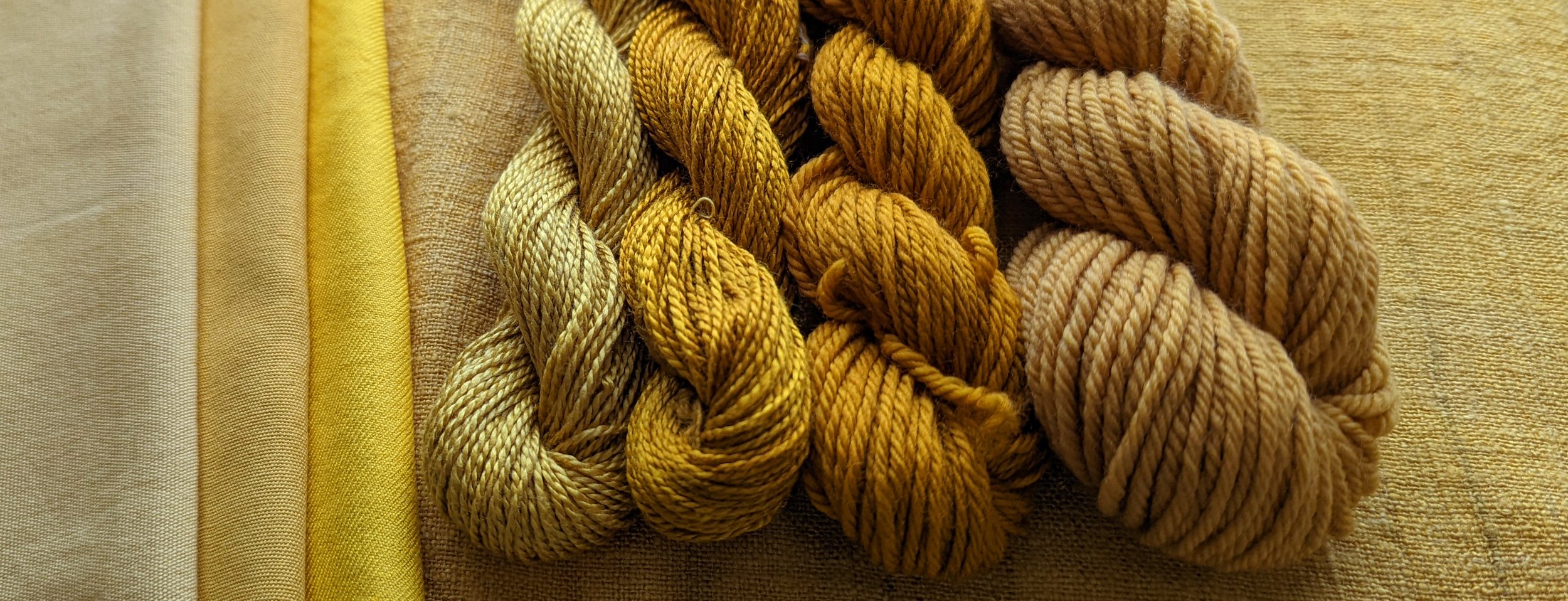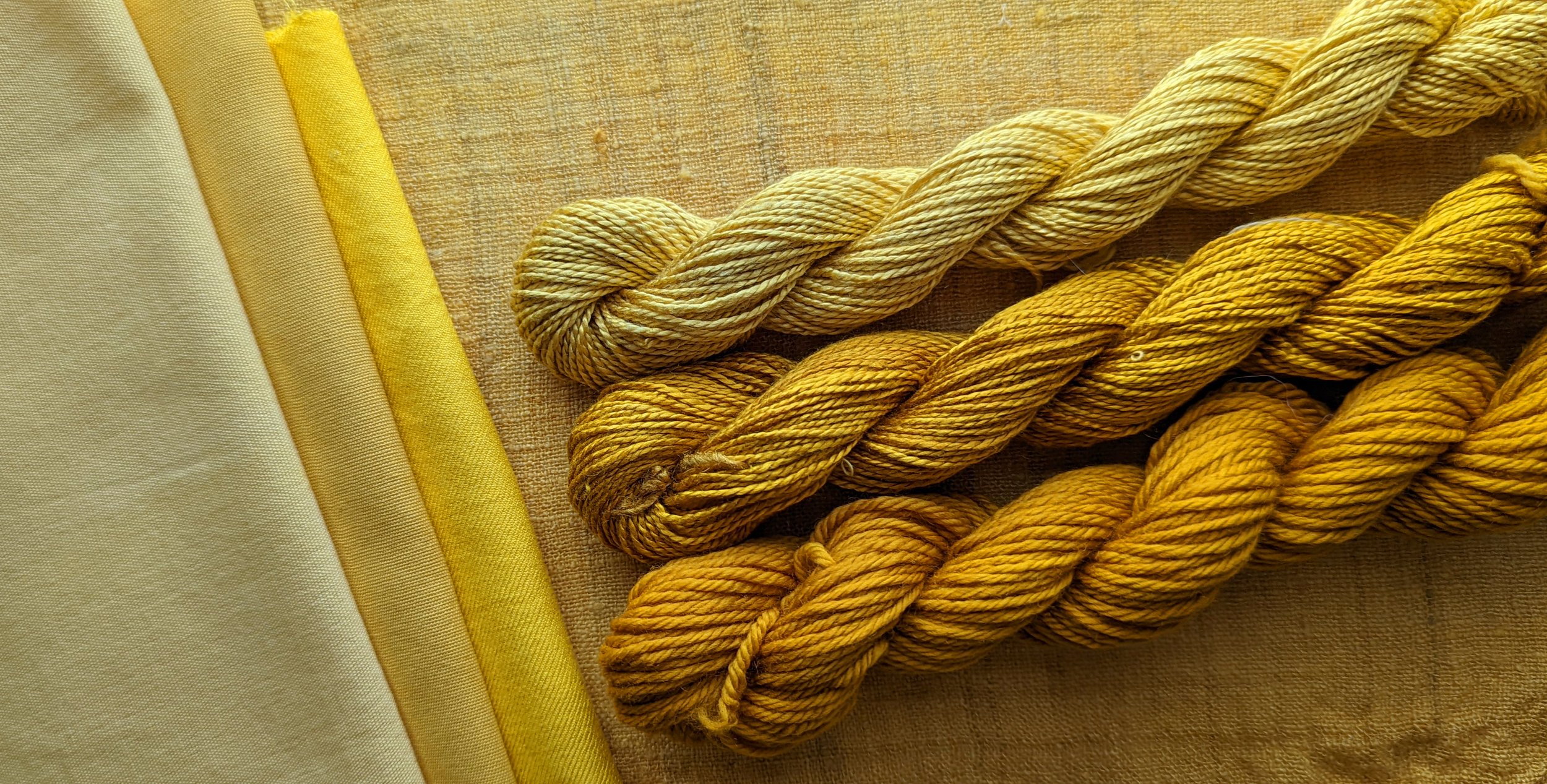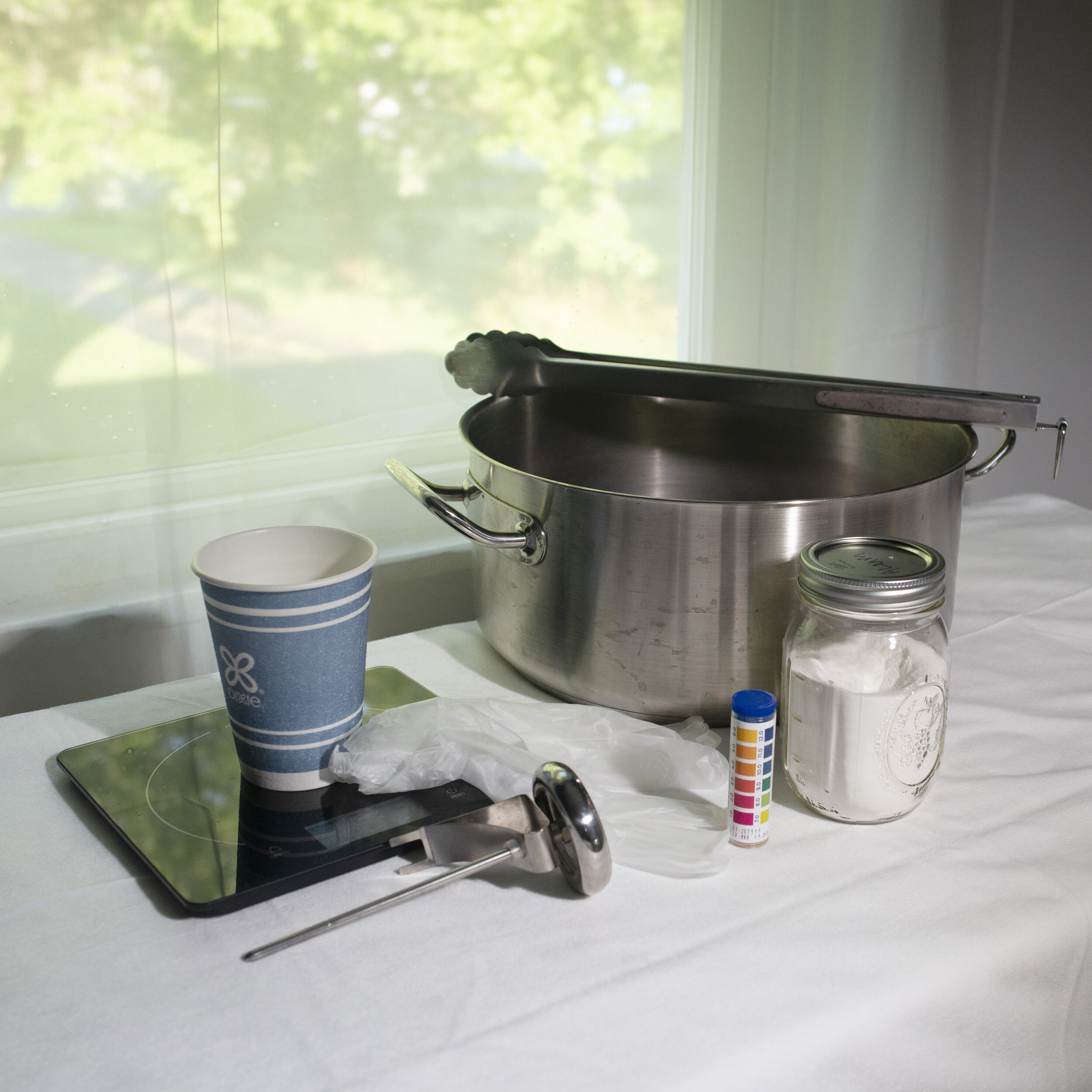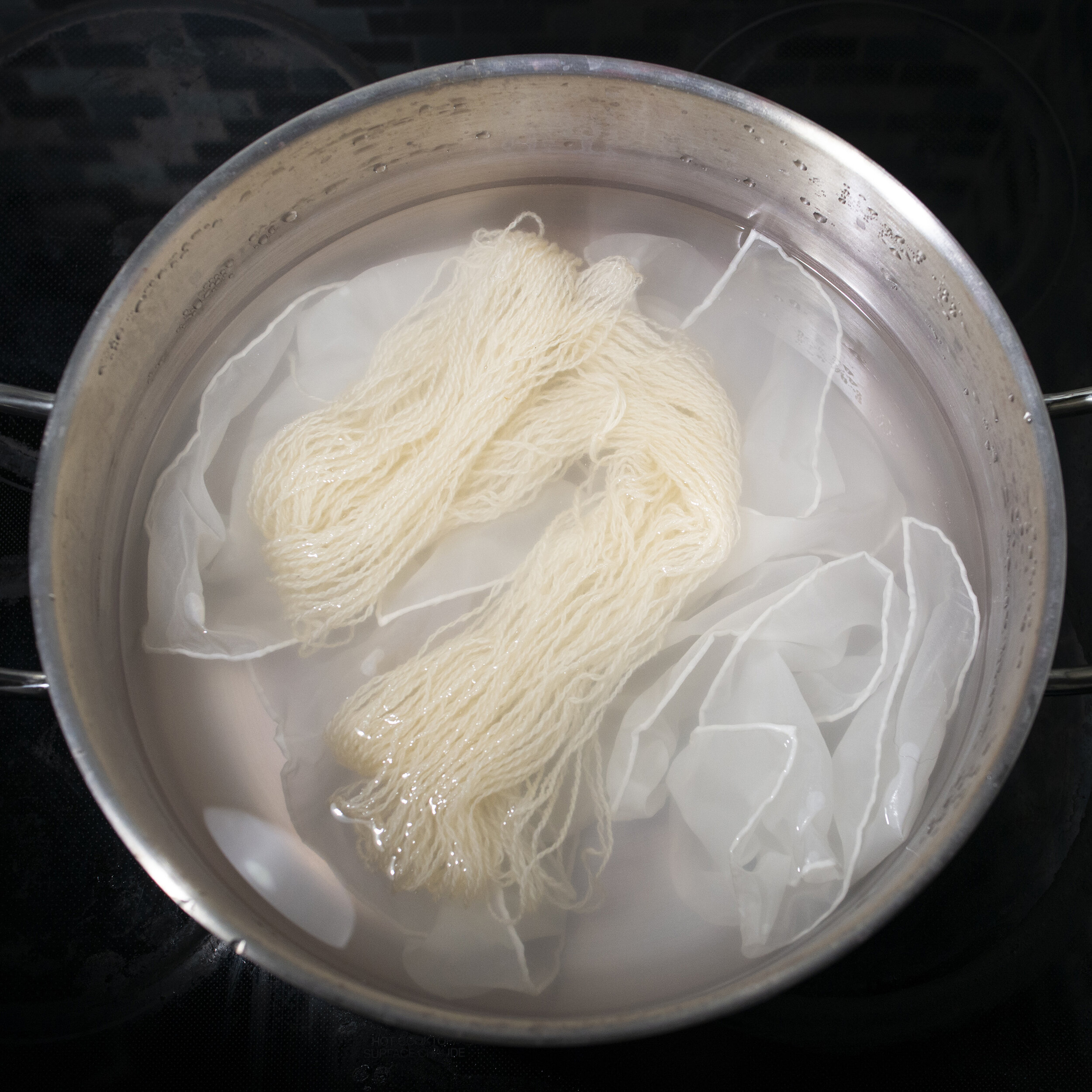
Onion Peel Extract
A Guide to Onion Peel Extract
Shepherd Textiles Onion Peel Extract is made from the skins of allium cepa, the standard yellow onion. Onion skins contain a variety of anthocyanin compounds that give them their dark colors, and those same compounds can be boiled out to produce a powerful fabric dye. Onion skins are also high in natural tannins, which makes them ideal for dyeing cellulose fibers like cotton and linen. Use it at 5% weight-of-fabric on unmordanted fiber for pleasant mustard hues. For really deep, rich, golden oranges, mordant with alum and dye a second time at 5% weight-of-fabric. Product of India. Produced by a GOTS (Global Organic Textile Standard) certified manufacturer.
1. Background on Onion Dyeing
A Pungent Favorite
The onion, allium cepa, needs no introduction: it is a foundational ingredient of cuisines all across the world. The common bulb onion has been consumed in Asia and Europe for thousands of years, although the exact time and place of its domestication is unclear. For many years the prevailing theory was that it was domesticated in Central Asia, somewhere between Turkey and Uzbekistan, but recent phylogenetic analyses have shown that hypothesis to be unlikely (Yusupov et al. 2021). Regardless of their mysterious origins, onions are almost universally appreciated for the flavor. Their flesh contains a variety of sulfide flavor compounds that give them their characteristic sharpness and heat. What is less well known is that the thin skin of the common onion is rich in anthocyanins, the same compounds that give many berries their dark color, and for centuries onion skins were one of the most common natural dyes.
Shepherd Textiles Onion Peel Extract is made from the skins of yellow onions sold in the market. Rather than being discarded as waste, the peels are collected so that the dye compounds can be extracted. Onion Peel Extract gives strong colors with just 5% weight-of-fabric, making it 15-20 times as powerful as dried onion skins in their raw form. Because onion skins are high in tannins, it gives good results on cellulose fibers like cotton. This is a great choice for the beginning dyer who prefers not to worry about mordants, dyers who prefer a completely natural process, or advanced dyers looking to experiment with modifiers.
2. Safety Precautions
DO NOT INGEST. This extract was prepared for textile dyeing, not as an herbal supplement.
Avoid eye contact. If eye contact occurs, rinse with cool water.
Not for use as a cosmetic additive; do not apply directly to skin or hair.
Open carefully to avoid spilling or creating dust.
If a spill occurs, quickly wipe up with a paper towel or disposable rag.
Onion Peel Extract can permanently dye clothing, countertops, rugs, utensils, or other property. Avoid contact with anything that is not meant to be dyed.
Use only dye pots and utensils dedicated to dyeing. Do not use any pots, containers, spoons, tongs, thermometers, or other utensils that will be used for food preparation.
Onion Peel Extract, and all dye baths and mordant liquors made while dyeing, should be kept out of reach of children and pets. Use only with adult supervision.
Shepherd Textiles, LLC is not liable for any misuse of this product or any unintended staining of your clothing, workspace, or other property. Use only as directed.
3. Recommended Supplies
Dye pot. Use a dye pot large enough to hold all your fibers, with plenty of room for them to move around and for the liquid to circulate freely. Otherwise, particles of dye may get stuck on the fabric and cause dark splotches.
Metal tongs. A pair of tongs is useful for stirring and taking fabric out. Use tongs dedicated to dyeing, and not for food preparation.
Rubber gloves. Wear rubber gloves while handling extract powder and while handling mordanted/dyed fiber before it is rinsed.
Candy thermometer. The best way to keep track of temperature is to use a candy thermometer that clips to the side of the dye pot.
Scale. Use a scale to weigh out fiber, mordant, and extract powder.
Alum mordant. The alum usually used for mordanting is aluminum potassium sulfate, also known as potash alum. It is the same alum that you can find in a jar in the spice section at the grocery store.
Disposable cup. For mixing the extract powder to a paste.
4. Preparation: Mordanting with Alum
Onion Peel Extract is tannic enough to be used without a mordant, but a mordant will make the colors much deeper and more light-fast. Alum is the standard mordant to use for orange-yellow shades. For best results, soak your fibers in water for a few hours before mordanting, so that the mordant will penetrate deeply and evenly. Make sure to weigh the fibers first, while they are still dry.
Alum will dissolve quickly into hot tap water.
Heat fibers for an hour at 180F, then allow to cool.
For protein fibers (wool, silk, alpaca, etc.): Mordant at 12% WOF with alum.
Weigh out the fibers you plan to dye (while they are dry). Multiply that weight by 0.12 to get the amount of alum you will need.
Fill your dye pot with hot tap water, leaving enough room for the fiber.
Weigh out the correct amount of alum and pour it into the dye pot. Mix with a spoon or metal tongs until it has dissolved.
Gently place your fibers into the mordanting solution.
Heat mordant bath to 180F and maintain heat for 1 hour. If you don’t have a candy thermometer, you will have to estimate the temperature. At 180F, steam vapor will be rising off the water but it will not be bubbling. If your mordant bath starts to bubble, turn down the heat.
Stir every 15 or 20 minutes to make sure fibers mordant evenly. If they do not, the dye will take better in some places than others.
After an hour, remove from heat and let cool to room temperature. Once cool, you can immediately proceed to rinsing, or you can leave the fibers to steep overnight in the mordant bath. This will improve results, especially when dyeing thick or tightly woven fabrics.
Remove cooled fibers. Wearing rubber gloves, gently squeeze excess mordant solution back into the pot. Rinse briefly in lukewarm water. The fiber does not need to be thoroughly washed, but any excess alum should be rinsed out. Set aside until ready to dye. Keep out of reach of children and pets.
Dispose of mordant solution according to local guidelines.
For cellulose fibers (cotton, linen, etc.): Scour well and [optionally] treat with a tannin before mordanting.
Onion Peel Extract has a good affinity for cellulose fibers, and it can be applied successfully to cotton even without a tannin pre-treatment or a mordant. However, to get really deep colors on cotton, Onion Peel Extract should be applied twice (see Part 6). The first round of dyeing with Onion Peel Extract will tan the cotton (a step traditionally referred to as engallage because oak galls were used) and make it receptive to alum, while laying down a good base of color. It can then be successfully mordanted. The second round of dyeing will bond with the mordant to produce a rich orange color. This second round of dyeing is not necessary if you are content with a lemon shade of yellow, but it will make it possible to get really dark orange-yellow colors on cotton.
Scour cellulose fibers well. Traditionally this is done in a highly alkaline soda ash solution. Add 2 tsp of soda ash and 1 drop of dish soap to a 5-gallon dye pot. Add cellulose fibers and heat to 180F-190F for an hour, stirring occasionally. Remove from heat, and when cool enough to handle, rinse and wring out well. Household detergents like Tide© are also alkaline (PH 11), so you can also toss the fiber in a washing machine on a high-temperature cycle with plenty of detergent. This will not clean them as deeply as simmering with soda ash, but it will yield much better results than not scouring at all.
Apply a tannin to the scoured fabric. Sumac Extract is a good choice in general, but you can also use Onion Peel Extract itself (see Part 5 & 6). To use, fill your dye pot with hot water, dissolve 5% WOF of the extract into the dye bath, and simmer for an hour. This process will make the cotton or linen more receptive to alum and lay down a base of color. Be sure to keep the fiber moving around: Sumac and Onion Peel Extract generally dissolve well, but some other tannins have insoluble particles that love to get stuck in fabric. If they do, it can cause splotches later on in the dyeing process. After an hour, let cool, remove fibers, and rinse well.
Mordant with alum as described above for protein fibers.

The Recipes
5. Recipe: All-Natural Onion
Onion Peel Extract gives soft, pleasant mustard hues on unmordanted fibers. Since onion skins are rich in natural tannins, it can even be successfully applied to cellulose fibers like cotton. It is an excellent dye for beginning natural dyers, since it does not require any pre-mordanting, PH adjustments, or other dyebath modifiers—just dissolve in water and simmer clean yarn or fabric. Use it at 5% weight-of-fabric (WOF) for mustard shades. To get deeper colors, follow the instructions in the next recipe.
Fill your dye pot with warm water, making sure there is enough room for the fabric to move around and for water to circulate freely.
Weigh out 5% weight-of-fabric (WOF) Onion Peel Extract into a disposable cup (multiply the dry weight of the fabric by 0.05 to get the correct amount of extract).
Add a little hot water to the cup and mix to form a thin slurry. Onion Peel Extract has a natural tendency to form clumps when it comes into contact with water: make sure to break these up, otherwise they may cause splotches on your fiber.
Pour the Onion Peel slurry into the dyebath and mix well. At this point the dyebath will be a dark orange-brown.
Add your unmordanted, fully wetted fibers to the dyebath (soaking in a bucket of tap water for an hour or two will make sure they are fully wetted, so the dye will penetrate thoroughly).
Raise the temperature to 180°F. Maintain for 1 hour, stirring every 20 minutes or so to make sure everything dyes evenly.*
After 1 hour, remove pot from heat and allow to cool to room temperature. You can cover and leave overnight to steep to deepen the color.
When finished dyeing, remove the fibers and rinse briefly in lukewarm water to remove any particles of dye. You can either proceed immediately to rinsing with detergent, or hang the fabric up to dry first to help the color set. Make sure to hang it up in the shade somewhere where dripping dye will cause no damage. Direct sunlight may fade the color before it has had time set.
For final rinsing, we recommend using a PH-neutral detergent like Synthrapol, which is designed to wash out loose dye. Follow the manufacturer’s directions for best results. CAUTION: Onion Peel Extract may bleed if not thoroughly rinsed out after dyeing.
Hang up to dry.
*Note: Increasing the temperature to a low boil (205°F) will deepen the color, especially on cotton. However, be cautious boiling fine wools like merino, since the heat and movement can cause them to felt. Silk, likewise, may lose some of its luster if boiled.
6. Recipe: Double-Dyed Onion
With an alum mordant, the colors produced by Onion Peel Extract are brighter and deeper. To get the deepest, richest possible colors out of onion skins, take advantage of the double-dye method. After a first round of dyeing (see Recipe 5), mordant the fibers with alum, and then dye them again. This method is especially useful for cellulose fibers like cotton—the first round of dyeing tans the cotton and makes it receptive to mordanting. During the second round of dyeing, the colors will come out deep and rich.
Follow the recipe for All-Natural Onion as described in Part 5. When finished dyeing, rinse the fibers well in lukewarm water but do not do a final rinse with detergent.
Mordant the dyed fiber with 12% alum, as described in Part 4. For best results, let the fiber steep in the mordant bath overnight.
When mordanting is complete, remove the fibers and rinse well in lukewarm water.
Repeat the dyeing process for All-Natural Onion as described in Part 5, using another 5% weight-of-fabric Onion Peel Extract. The fibers should develop a noticeably darker shade than they did during the first round of dyeing.
When finished dyeing, remove the fibers and rinse briefly in lukewarm water to remove any particles of dye. You can either proceed immediately to rinsing with detergent, or hang the fabric up to dry first to help the color set. Make sure to hang it up in the shade somewhere where dripping dye will cause no damage. Direct sunlight may fade the color before it has had time set.
For final rinsing, we recommend using a PH-neutral detergent like Synthrapol, which is designed to wash out loose dye. Follow the manufacturer’s directions for best results. CAUTION: Onion Peel Extract may bleed if not thoroughly rinsed out after dyeing.
Hang up to dry.
6. Recipe: Moss Green
Iron shifts the color of Onion Peel Extract toward a moss or olive green. This can be done by mordanting the fabric in a 2% weight-of-fabric iron solution rather than mordanting it with alum. Iron solution can also be applied after dyeing as a quick afterwash, as described below.
Follow the recipe for All-Natural Onion (Part 5) or Double-Dyed Onion (Part 6). The deeper the color of orange on the fabric, the deeper the green will be after iron is applied.
Make sure the fibers are fully soaked through; if they have had time to dry after dyeing, soak them in tap water for an hour or two.
Fill a dye pot with lukewarm water and dissolve 2% weight-of-fabric iron powder ferrous sulfate) into it. If possible, we recommend using a separate dyepot for iron solutions. If it is not completely cleaned out after each use, any iron left in the pot will change the color of subsequent dyeing sessions.
Place the dyed fibers in the mordant bath and gently heat. The fibers should begin to change color quickly. Using tongs, remove them from the mordant bath as soon as they have “saddened” or turned moss green. Do not leave fibers to steep in an iron bath, as iron will eventually corrode them. Wear rubber gloves to handle the fiber until it has been thoroughly rinsed.
When they are cool enough to handle, rinse the fibers well in lukewarm water to remove any excess mordant, then rinse thoroughly with a PH-neutral detergent like Synthrapol.
CAUTION: Iron powder is an irritant and may be harmful if ingested, especially for children and pets. Please read your vendor’s safety sheet (SDS) before using iron as a mordant. Wear gloves, a mask, and eye protection when handling iron powder, iron mordant baths, and iron-mordanted fibers before they are fully rinsed, and work in a well-ventilated space. Keep iron powder and iron mordant baths out of reach of children and pets. Dispose of the mordant bath according to local regulations.
All images and text are copyright of Shepherd Textiles, LLC. Do not reproduce without permission and attribution.






